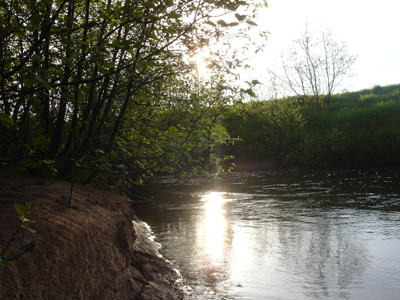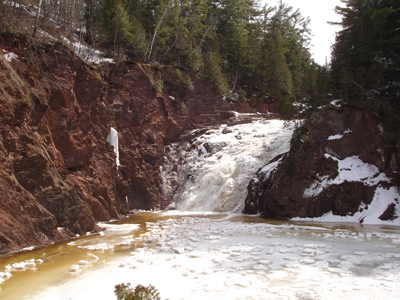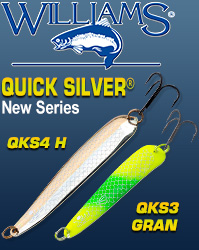FENCEROWS...“Penokee Iron”
By John Luthens
In the high reaches of northern Wisconsin, the Penokee Hills angle skyward above the Lake Superior shore like an iron fist. Deep pine valleys rise through stands of aspen, birch and maple, sliding above onto rounded outlooks that were once great mountains, mellowed now by the centuries into a remote stretch of land.
Coursing below the ridges is the water. It channels through seams of rock and under the canopies of trees and tangled swamps.
The White River holds a thick path along the western edge. It also holds monster trout, sulking in impossible places and waiting to be lured out of the deep reaches of the Bibon Swamp for the gaudy hexagenia mayfly hatch of sultry summer. I have never been lucky enough to time the hatch, but I try every year with baited anticipation.
 |
| Last light on the Marengo River. |
Wild named rivers like the Marengo rush the center of the range, starting in rocky hills above before slowing into easy-running pasture curves below. I wrestled with two brown trout from the same deep hole one rainy afternoon, back-to-back and they both pushed 20 inches. It is a diverse and beautiful river, but worthy of caution after a heavy rain. Then the Marengo is dark-stained and fast, and the dripping forest comes alive like it has done since the earliest of times, when French-Canadian wanderers first called the area “maringouin”-Marengo means mosquito.
The Montreal River borders the east, screaming down 1000 ft. from its source in eastern Iron County, rolling through the old mining roads of Hurley and cutting the Michigan border, before plunging in spectacular fashion into the greatest of freshwater lakes at Superior Falls.
 |
| Montreal River at Superior Falls. |
At night are the silent sounds from the whole of the Penokee watershed; frogs and crickets, trout streams curling over rocks. Maybe there is the screech of a night owl in the hills. And if you stand in those hills at night, it almost hurts the eyes to see the flash of far northern lights over the lake and the shine of impossible stars stretching above.
The iron ridges of the Penokees and their waters are intertwined. Summit after valley; and through breaks in the tree line, you can see the water coursing through Iron and Ashland Counties, flowing in an untamed state that was revered by Native Americans and is nearly unchanged since the first white explorers journeyed into its iron-bearing wilderness.
That is a simple introduction to the Penokee Range; a simple introduction to a land that has been compared to the Florida Everglades for its rare and diverse ecosystem. I tend to believe that it’s a place holding more secrets than could ever be revealed in a lifetime of wandering. Logically, it’s the perfect place to rip through for an open-pit iron mine.
Now, I’ve fished the edges of the range for years. I’ve stood in the hills and I’ve lost myself for hours on its back-country trails. I stand for outdoor conservation and I am a trout fisherman, so I am biased. Some have even accused me of stretching the truth-but like I said, I’m a trout fisherman, it goes with the territory.
I also live in southeastern Wisconsin, some 300-odd miles and a cross-section of state removed from the proposed mine site. I am not a local northern Wisconsin resident and the mine isn’t getting dug in my back yard, not that my backyard is any Wisconsin scenic treasure to begin with. I can’t even dig out a decent garden.
I drive a vehicle built with refined steel that was once iron in the ground. Someone had to dig it out or we’d still be riding in buckboard wagons with wooden wheels. Of course, we’d have to cut the trees for the wagons someplace too, which is O.K. as long as it’s not from the trees in my backyard. I wouldn’t mind if you took my neighbor’s maples. Then I wouldn’t have to rake as many leaves when the autumn wind blows east from his yard and Mother Nature ends up sticking me with the bill.
It is also true that steel is one of the most common ferrous metals to recycle. My vehicle is certainly qualified judging by its beat condition. Iron is even easier. And it’s far cheaper than mining it. Where is all this newly-mined ore slated for?
The heads of our state government says that the mine will create an influx of jobs into a northern economy that is sorely in need of a boost. That may well be the case. But at what cost to the northern lifestyle? And at what cost to the image of Wisconsin itself as a Mecca for outdoor enthusiasts from around the country?
Before anyone in Madison starts talking economy boost, I’d suggest going to the northern counties, seeing the land and talking to the people who live there. Many are there for a reason, in a place where nature is allowed to run its course, where the mosquitoes and black-flies can get voracious, where the winters can be downright brutal, but also where the bustling sounds of cities are few, the sun shines through the pines and the wind ripples untouched stretches of water.
High tension power lines and substations, processing plant infrastructure, super-capacity wells, railroad lines and fortified roads; there is no doubt that these will add hundreds of jobs. Where the workers will come from and when, and what training is required for these highly-skilled set of professions, and if they will choose to pack in their families and stay in a northern climate, that remains open to debate.
Then there are environmental concerns that have been well-documented: Water management and tailing basins for the by-products of taconite-ore production, erosion control and the possibility of sulfides leaching from the tons of waste rock that will need to be piled up like mini-mountains in order to access the deep beds of iron ore. The wild rice beds of the Kakagon Sloughs along the coastal wetlands of Lake Superior stand in real threat of silently withering and folding into the cold reaches of the lake.
These are odds that need to be weighed. I’m certain that the Environmental Protection Agency, the Department of Natural Resources and the U.S. Army Corps of Engineers will do everything in their power to ensure that the natural order of the Penokee Range doesn’t become too much of a slippery slope to handle. But they aren’t the ones holding the big-money purse strings.
What is certain, is that the face of the Penokees will be forever altered by a large-scale mine. Part of the northern Wisconsin ecosystem will be gone. Acres of forestland will be cut to nothing, which I give you will make for a clearer view from the hills, but there will be high-intensity arc lights and humming power lines where once there were stars. The water will still be there and there may still be trout swimming, but fishing for them won’t be the same when thundering blasting caps from the ridge mine block out the murmuring of the streambeds and bring down a rain of taconite-iron powder.
We’re not talking about the economic implications of moving a mountain here. We’re talking about knocking one down. We’re talking about knocking out a part of Wisconsin that even picture postcards for the local tourism bureaus would be hard pressed to capture.
Before we do that, we need to stop and really think about it. We need to look at the whole state picture. It’s true that the Wisconsin state flag depicts a miner and a pickaxe, and we are the “Badger State.” But the state motto is “Forward” and this is not the shaft mining of old. We can’t put this mountain back together once it’s gone.









